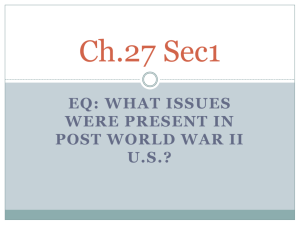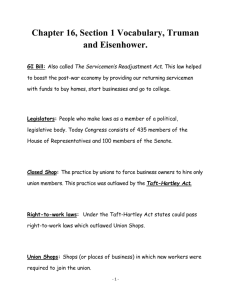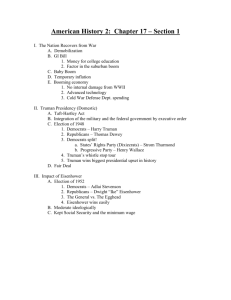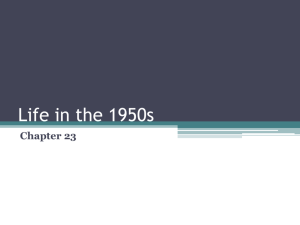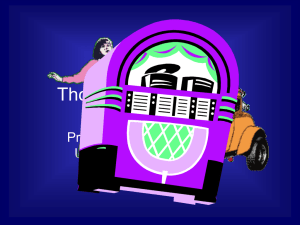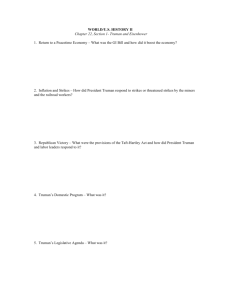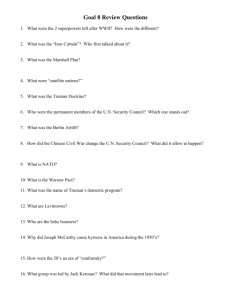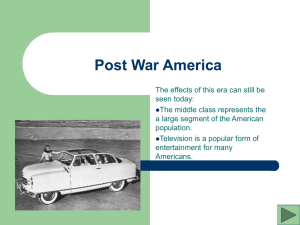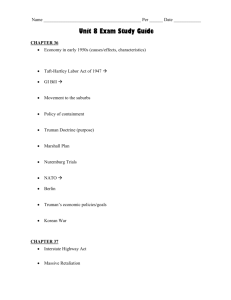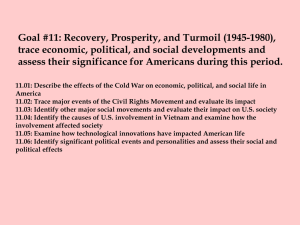Chapter 20: The Postwar Years at Home
advertisement
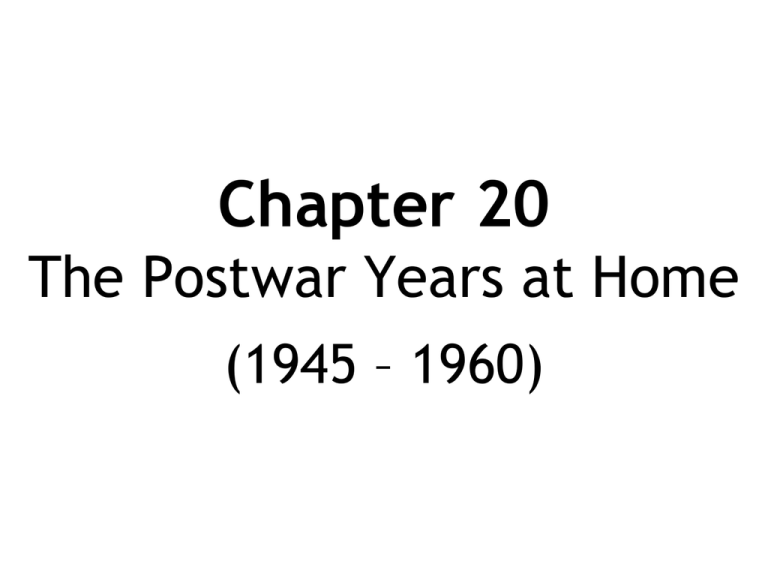
Chapter 20 The Postwar Years at Home (1945 – 1960) Section 1 The Postwar Economy Setting the Scene • items were rationed or not produced at all during the war • people were eager to acquire everything the war and the Depression had denied them • began to spend large sums of money on recreation Businesses Reorganize • per capita income – the average annual income per person increased • with research and development funded by the government, new products were produced – Ford – Chrysler – General Motors – General Electric – Westinghouse • conglomerate – corporation made up of three or more unrelated businesses, that is better able to defend itself against economic downturns – International Telephone and Telegraph, Avis Rent-a-Car, Sheraton Hotels, Hartford Fire Insurance, & Continental Baking • franchise – business that contracts to offer certain goods and services from a larger parent company – use the company’s name, suppliers, products, and production methods • McDonald’s Technology Transforms Life • Television – live broadcasts made shows exciting to watch – average American family watched 4-5 hours a day – also became a powerful new medium for advertisers Father Knows Best American Bandstand The Mickey Mouse Club Howdy Doody I Love Lucy • The Computer Industry – Grace Hopper – pioneered creation of software & coined term debugging when she removed a moth from a relay switch – transistor – tiny circuit device that amplifies, controls, and generates electrical signals • also took up less space and generated less heat • Nuclear Power – nuclear fission – produce heat to generate steam and drive electrical turbines • first nuclear-powered submarine (USS Nautilus) • first nuclear power plant • Nuclear Power Plant in Glen Rose, Texas – approx 87 miles from Gatesville • Advances in Medicine – Dr. Jonas Salk & Dr. Thomas Francis developed a polio vaccine • introduced on the Tenth Anniversary of FDR’s death – antibiotics like penicillin introduced – new era of surgical advances to correct heart defects Changes in the Work Force • new machines began to assume many of the jobs previously performed by people – automation • demand for more people to keep growing organizations running • growth of the service industry • Advantages – buildings were clean – offices were bright – physically work was less exhausting – not as dangerous – could rise into executive positions • Disadvantages – less connection with products & services company was providing – pressure to dress, think, and act alike Suburbs and Highways • the baby boom • Moving to the Suburbs – retreated from aging cities to the suburbs – GI Bill of Rights – gave soldiers low-interest mortgages to purchase new homes and provide them with educational stipends for college or graduate school – William J. Levitt – built houses in just weeks instead of months – some complained that the developments all looked too much alike “Little boxes on the hillside Little boxes made of ticky-tacky Little boxes on the hillside Little boxes all the same. There’s a green one and a pink one And a blue one and a yellow one And they’re all made out of ticky-tacky And they all look just the same.” - Malvina Reynolds, “Little Boxes” • Cars and Highways – stores began to move from cities to shopping centers located in the suburbs – new car designs every year – Interstate Highway Act – to build an interstate road system more than 40,000 miles long • theoretically allowed for the evacuation of major cities in the event of a nuclear attack – gas stations, repair shops, parts stores – drive-in movies and restaurants – vacations at national parks, seaside resorts, and amusement parks The Growth of Consumer Credit • gas companies began offering credit cards to loyal customers • consumer credit debt rose from more than $8 billion (1946) to $56 billion (1960) – used credit to purchase washing machines, vacuum cleaners, and television sets Section 2 The Mood of the 1950s Setting the Scene • Americans began to value security over adventure • happy with the apparent harmony between individuals and groups Comfort and Security • Tootle the Engine – young train engine, who thought it was more fun to play in the fields than stay on the tracks • “Always stay on the track no matter what.” • Youth Culture – little interest in the problems and crises of the larger world – more children able to complete secondary school – expected to stay in school, only part-time jobs (baby-sitting) – businesses began selling to the youth market – bobby socks / poodle skirts / letter sweaters – teenage girls collected items such as silver and linen to prepare for marriage, often just after high school • A Resurgence in Religion – people began to flock back to churches – found hope in the face of the threat of nuclear war – Dial-a-Prayer – growth of evangelists – 1954 – Congress adds “under God” to the Pledge of Allegiance – “In God We Trust” Men’s and Women’s Roles • roles defined by social and religious traditions – men – go to school, find a job and support wives and children – women – supporting role of keeping house, cooking meals, and raising children Challenges to Conformity • Women at Work – norm was for women to leave work after they got married (not all did) • secretaries, teachers, nurses, sales clerks – Betty Friedan – The Feminine Mystique • Tupperware Parties – home-based sales were less intimidating than door-to-door • Youthful Rebellions – some young people rejected the values of their parents – Rebel Without a Cause – James Dean – The Catcher in the Rye – J.D. Salinger • struggles to preserve own integrity despite the fierce pressure to conform – Alan Freed – radio disc jockey who began playing black rhythm-and-blues • “Moondog Rock ‘n’ Roll Party” – Chuck Berry, Little Richard, Fats Domino, Bill Haley and the Comets, Jerry Lee Lewis, Buddy Holly Chuck Berry Fats Domino Bill Haley and the Comets Jerry Lee Lewis Buddy Holly Little Richard – Elvis Presley • “Don’t Be Cruel” • “Hound Dog” • “Heartbreak Hotel” – rock-and-roll • felt that it threatened many who were comfortable with racial segregation • didn’t like the idea of black and white teenagers going to the same concerts or dancing to the same music – “Beat Generation” – beatniks • promoted spontaneity or acting out at a moment’s notice without planning – Jack Kerouac – On the Road – Allen Ginsberg – “Howl” I saw the best minds of my generation destroyed by madness, starving hysterical naked, dragging themselves through the negro streets at dawn looking for an angry fix; Angel-headed hipsters burning for the ancient heavenly connection to the starry dynamo in the machinery of the night. –Allen Ginsberg – “Howl” Section 3 Domestic Politics and Policy Setting the Scene • 1950s called the conservative years Truman’s Domestic Policies • had a scattershot approach to government • offered a new set of proposals in every speech • The Peacetime Economy – reconversion – the social and economic transition from wartime to peacetime – wages failed to keep up with prices – strikes in various prominent industries – began to limit the power of unions – Taft-Hartley Act – allowed the President to declare an 80-day cooling off period during which strikers had to return to work , if the strikes were in industries that affected national interest – required union officials to sign oaths that they were not Communists – vetoed by Truman, but passed by Congress Senator Robert A. Taft • Truman’s Fair Deal – 21-point program designed to promote full employment, a higher minimum wage, greater unemployment compensation, housing assistance, national health insurance program, control atomic energy • Truman on Civil Rights – “I am not asking for social equality, because no such things exist, but I am asking for equality of opportunity for all human beings, and, as long as I stay here, I am going to continue the fight.” – federal anti-lynching law, abolish the poll tax, board to prevent discriminatory practices in hiring – biracial committee formed on Civil Rights – banned the discrimination in the hiring of federal employees – end to segregation and discrimination in the armed forces The Election of 1948 • Truman ran against Republican Thomas E. Dewey – campaigned against the Republican Congress (80th ‘Do Nothing’ Congress) – almost all experts and pollsters had picked Dewey to win – Truman wins in an astounding upset • 22nd Amendment – limited presidents to two terms (1951) Eisenhower and the Republican Approach • Ike - nickname • “K1C2” – Korea, Communism, Corruption • promised to end the Korean War • Vice-President Richard Nixon • The Checkers Speech – during the election, Nixon was accused of receiving illegal gifts from political friends – many proposed Eisenhower dump him from the ticket – Nixon gave a televised speech where he admitted that he had received one gift, a little cocker spaniel they named Checkers – people demanded Nixon continue • Eisenhower as President – worked behind the scenes – won reelection in 1956 • Modern Republicanism – wanted to limit the President’s power and increase the authority of Congress and the courts – cutting spending, reducing taxes, and balancing the budget – “dynamic conservatism” – Eisenhower’s Cabinet • favored big business • successful businessmen, plus one union leader – “eight millionaires and a plumber” – attempt to balance the budget backfired, but maintained a mood of stability – minimum wage increased from 75¢ to $1.00 • Meeting the Technology Challenge – National Aeronautics and Space Administration (NASA) – formed in 1958, as an independent agency for space exploration – National Defense Education Act – improve science and mathematics instruction in schools to meet the scientific and technical challenge of the Soviet Union – money to build science and foreign language facilities for schools
